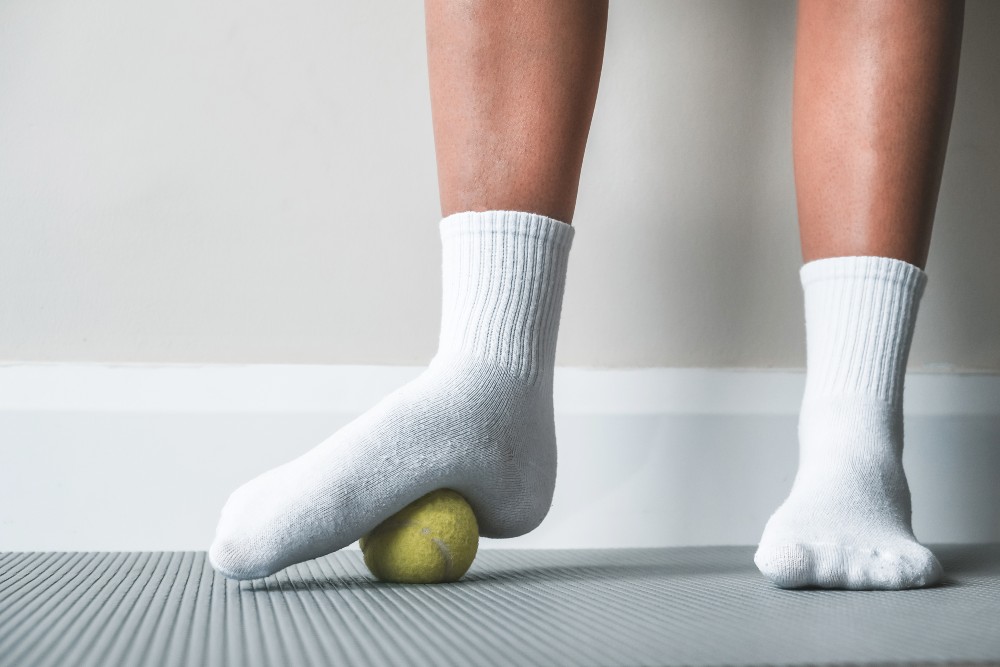Do You Have Morning Heel Pain?
While we all experience sore feet once in a while, there’s a certain kind of pain that’s not quite so normal. Morning heel pain, whether stabbing, aching, or general soreness, can be a symptom of a condition known as plantar fasciitis and should be seen by one of our podiatrists as quickly as possible.
What is Plantar Fasciitis?
Plantar fasciitis is the term describing inflammation of the plantar fascia, or the tissue along the bottom of the foot. Overstretching the area, flat feet, repetitive motions, and other causes can create small tears in this band of tissue, causing major discomfort, and even severe pain in some cases.
Other Symptoms of Plantar Fasciitis
The heel pain described above is the main symptom patients present with when a plantar fasciitis diagnosis is made, though there are several other signs that your plantar fascia might be injured or inflamed. These include:
- Pain in the arch of the foot
- Pain that increases after exercise
- Pain that is worse in the morning or after prolonged periods of standing or sitting
- Swollen heel or heels
- Tight Achilles tendon
What Can You Do to Treat it at Home?
While seeing our podiatrists is the best course of action, there are several activities you can perform at home to relieve the pain that comes with plantar fasciitis. If you’re experiencing morning heel pain or any other plantar fasciitis symptoms, give these a try to find some relief:
RICE
No, you don’t have to put your foot in a bowl of rice, don’t worry! RICE is an acronym, and it stands for rest, ice, compression, and elevation. It’s broken down as follows:
R: Rest — Your body is signaling you through pain that it needs rest in the affected area. Try to stay off your feet when pain is present, if possible.
I: Ice — Ice the area to decrease inflammation, swelling, and to find some relief from the pain.
C: Compression — Wrap the area in a bandage or compression wrap to provide support and prevent additional swelling.
E: Elevation — Elevate the affected foot/feet as much as your schedule allows throughout the day, or when relaxing at home in the evenings.
Stretches
Stretches help relieve the pain of plantar fasciitis, as they work to relax the plantar fascia into its normal position while strengthening it and reducing inflammation. There are several options for stretches, including the calf stretch and the plantar fascia stretch, among others. You can do a quick search on YouTube for guided stretches for plantar fasciitis.
Tennis Ball Massage
The tennis ball massage is also effective in relieving plantar fasciitis pain. It’s simple to do — just sit in a comfortable chair or on your couch, placing a tennis ball under the arch of your foot. Then use your foot to roll the tennis ball back and forth, which stretches and strengthens your plantar fascia, decreasing pain and inflammation. This can be done once or more daily, just don’t overdo it.
Get Supportive Shoes
Since the plantar fascia spans the arch of your foot, supportive shoes can be extremely helpful in relieving your symptoms. Sufficient arch support for your arch type (flat, normal, or high) will allow your plantar fascia to relax while you walk, stand, or perform exercises.
Should You See Our Podiatrists?
If you’re experiencing morning heel pain or any other plantar fasciitis symptoms, it’s a good idea to come in and see us. We’ll help determine if plantar fasciitis is the cause of your symptoms while recommending some options for treatment that work best for you.
What Our Podiatrists Can Do to Treat Plantar Fasciitis
Custom Orthotics
Custom orthotics are shoe inserts that are molded to the unique shape of your foot. These are particularly helpful because they provide support in all necessary areas of the foot beyond what
supportive shoes can do. They can also be different for each foot, to ensure you get the correct support for your individual foot shape.
Night Splints
Night splints for plantar fasciitis are uniquely shaped to gently stretch the calf muscles while you sleep. This works to relax the plantar fascia by strengthening the calf muscle, which is akin to the calf stretch mentioned above. Using these can provide significant relief in plantar fasciitis pain.
MLS Laser Therapy
Multiwave Lock System (MLS) Laser therapy is a minimally invasive, safe treatment for plantar fasciitis. The laser works to reduce pain and inflammation by penetrating the deep layers of tissue in the plantar fascia, relaxing the tension, and repairing the injuries that are causing the inflammation and pain.
Regenerative Medicine
Regenerative medicine is the process of regrowing, replacing, or repairing damaged cells. In the case of plantar fasciitis, this may involve the use of plasma injections, stem cell therapy, and other innovative (and safe) options. Our podiatrists are skilled in these treatments and will happily walk you through your options to determine which is the best fit for you.
Surgery (Extreme Cases Only)
In extreme cases where other methods have been unsuccessful, surgery may be an option. Plantar fasciitis surgery involves cutting part of the plantar fascia to release the tension responsible for the associated pain and inflammation. This is only performed occasionally, and once all other options have been exhausted.
Contact Us for Heel Pain Relief!
For the much-needed relief you deserve from your morning heel pain, contact our office to schedule an appointment. Our podiatrists will work with your needs, offer solutions that best suit your unique situation, and get you back on your feet without pain as quickly as we can!

